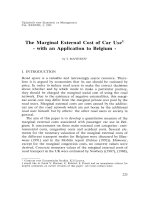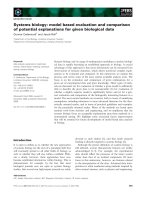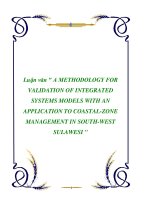evaluation and comparison of management strategies by data envelopment analysis with an application to mutual funds
Bạn đang xem bản rút gọn của tài liệu. Xem và tải ngay bản đầy đủ của tài liệu tại đây (2.59 MB, 316 trang )
Copyright
by
Chester Lewis Wilson
2006
The Dissertation Committee for Chester Lewis Wilson
certifies that this is the approved version of the following dissertation:
Evaluation and Comparison of Management Strategies
by Data Envelopment Analysis with an Application to Mutual Funds
Committee:
William W. Cooper, Supervisor
Timothy W. Ruefli, Supervisor
Patrick L. Brockett
Linda L. Golden
Zhimin Huang
Evaluation and Comparison of Management Strategies
by Data Envelopment Analysis with an Application to Mutual Funds
by
Chester Lewis Wilson, B. A.
Dissertation
Presented to the Faculty of the Graduate School of
the University of Texas at Austin
in Partial Fulfillment
of the Requirements
for the Degree of
Doctor of Philosophy
The University of Texas at Austin
May 2006
UMI Number: 3245797
3245797
2007
UMI Microform
Copyright
All rights reserved. This microform edition is protected against
unauthorized copying under Title 17, United States Code.
ProQuest Information and Learning Company
300 North Zeeb Road
P.O. Box 1346
Ann Arbor, MI 48106-1346
by ProQuest Information and Learning Company.
Dedication
This dissertation is dedicated to the memory of my father,
Joe Foster Wilson,
MSgt USAAC/USAF (Purple Heart, Pearl Harbor),
PhD (History, University of Georgia),
and to my mother,
Mary Elizabeth Richards Valdez Wilson,
MA (Spanish and French, Pan American University).
v
Acknowledgements
I was able to undertake this dissertation because of guidance and assistance from
so many past instructors and colleagues. Though they are here unnamed, they are well
remembered with gratitude for all we did together and for all the benefits that I continue
to draw from those experiences. I also want especially to thank my parents who were
always encouraging and eager to offer support.
For this immediate project, I am deeply indebted to the members of my
committee. Each, Dr. Brockett, Dr. Golden, and Dr. Huang, gave of his or her unique
talents and contributed immensely to this dissertation’s completion and to any good
qualities it may have.
My greatest and most long-standing debts and obligations are to my two
supervisors. It took their combined talents and efforts to lead me through the twisting
process that produced this work. It would have gone more smoothly and productively if I
had been quicker and smarter, but they did not abandon me. I have known and worked
with Dr. Ruefli from the first semester of my first graduate program and the intellectual
excitement of learning from and working with him has always worked as a powerful
incentive for me. His perspicacity over such a broad range of endeavors and his sure
ethical judgment are not often equaled. His guidance in the more practical aspects of
completing this work was also decisive.
I have been fortunate to study with some of the most intellectually creative and
vi
morally upright mentors of our time, and among their first rank is Dr. Cooper. He
continues to surprise me with what he has done in theory, practice, and public service and
with his constant and easy flow of ideas. His guidance has always been so rich with
insight that I continue to gain from it even long after it has been offered. He gives
unstintingly to those with whom he works, and we are all enriched by his kindness and
generosity.
Finally, I am happy to acknowledge my first obligation in graduate study, to Dr.
Abraham Charnes. Dr. Charnes also was a man of brilliant mind and firm principle. He
and Dr. Cooper were long time collaborators and they produced an immense body of
work which has served greatly to advance the human effort of understanding and
improving the world. They have left the only durable monuments, if there be any in this
universe, as have all the members of my committee, both through a body of work which
contributes to the achievement of humankind and through the living legacy of the
students and colleagues whom they have trained and guided to carry on the same
tradition.
vii
Evaluation and Comparison of Management Strategies
by Data Envelopment Analysis with an Application to Mutual Funds
Publication No. ____________
Chester Lewis Wilson, Ph. D.
The University of Texas at Austin, 2006
Supervisor: William W. Cooper
Supervisor: Timothy W. Ruefli
A new categorical schema for strategic management is developed; a methodology
for its implementation is elaborated; an application to mutual funds based on micro-
economic theory is demonstrated; and results which establish quantitative measures for
evaluating strategies, improve measures of managerial performance, and establish a new
viii
method of evaluating portfolio performance with guidance for potential mutual fund
shareholders is presented.
The evaluation of strategies themselves depends fundamentally on distinguishing
them from their execution, from their realization in practice. The accounting definition
of strategy, “a plan of action used to guide or control other plans of action” finds an
observable, indeed measurable, example in the strategic choices of mutual funds, which
are required by law to declare and conform to the general strategy by which they conduct
investment management.
The methodology to exploit the declared strategies and performance data of mutual
funds is Data Envelopment Analysis (DEA), a nonparametric linear programming
method of analysis for use with empirical data. By producing a piecewise linear frontier
based on the Pareto-Koopmans efficient performers, DEA provides a basis for measuring
performances and facilitates sensitivity analysis. Data Envelopment Analysis measures
assume no prior, underlying functional form (such as regression equations or production
functions) to relate input to output or to other variables.
An evaluation of a selected group of mutual funds illustrates the general DEA
method and evaluates the actual performance of the funds. Then a new application
involving an extended, three-stage Data Envelopment Analysis separates the performance
of the investment strategies from the effects of managerial shortcomings and abilities to
implement the strategies. This makes it possible to separately identify and evaluate what
a strategy can accomplish. It also makes it possible to evaluate separately short-run from
ix
long-run performance. Finally, DEA identifies benchmarking possibilities for removing
these short-run deficiencies.
This new method for evaluating strategies and shortcomings in performance is
demonstrated by application to mutual funds, which display striking contrasts in
managerial performance and strategic potential. Although demonstrated with mutual
funds, this method is not restricted to such applications. Indeed, the methods in this
thesis provide a new way of evaluating investment potentials by distinguishing between
actual short-run performance and long-run potentials.
x
Table of Contents
List of Tables
List of Figures
Chapter 1 Introduction
Section 1 Overview
Section 2 Plan of Presentation
Chapter 2 Strategy
Section 1 Origins of the Meaning of Strategy
Section 2 Military Definitions
Section 3 Mathematical Definitions
Section 4 Strategy for Management
Section 5 Implementation of Strategy
Chapter 3 Mutual Funds Industry
Section 1 Advantages of Mutual Funds for Strategic Analysis
Section 2 Ancient Forms of Financial Instruments
Section 3 Mutual Fund Precursors
Section 4 Development of Mutual Funds in the United States
Section 5 The Relation of Management Companies and Shareholders
Chapter 4 Evaluation of Mutual Funds
Section 1 Introduction
Section 2 Modern Portfolio Theory
Section 3 Portfolio and Capital Theory Evaluation of Mutual Funds
Section 4 DEA Evaluations of Mutual Funds Performance
xiv
xvii
1
6
20
23
26
29
40
45
47
54
62
72
75
80
84
98
xi
Chapter 5 Methodology for Evaluation of Strategies by Data Envelopment
Analysis
Section 1 Introduction
Section 2 Early Definitions of Economic Efficiency
Section 3 Data Envelopment Analysis
Section 4 BCC Mathematical Model
Section 5 Mann-Whitney Rank Analysis
Section 6 Comparison of Strategies
Chapter 6 Analysis and Results
Section 1 Data Source, Population, Variables, Software
Section 2 Standard Data Envelopment Analysis of Mutual Funds from
Both Strategy Groups Evaluated Together
Section 3 Performance of Mutual Fund Strategies
Section 3.1 Step One: Performance of Mutual Funds within Their
Separate Strategic Categories
Section 3.2 Step Two: Projection of Inefficient Funds to Their
Respective Efficiency Frontiers
Section 3.3 Step Three: Evaluation of Performance of Mutual
Fund Strategies by Comparison of Efficient Frontiers—Joint
Exemplar DEA
Section 3.4 Step Four: Performance of Mutual Fund Strategies by
Comparison of Efficient Frontiers—Rank Analysis
Section 4 Risk-Return Characteristics of Strategic Categories
Section 5 Strategic Analysis
Section 5.1 Benchmarking Peer Groups: Reference Sets and Their
Convex Combinations
Section 5.2 Targets: Efficiency Projection Values
Section 5.3 Dual Multipliers: Optimal Weights
Section 6 Conclusions
121
124
138
144
152
154
160
163
167
169
172
173
176
177
185
187
193
201
214
xii
Chapter 7 Conclusions, Limitations, and Future Research
Section 1 Contributions and Limitations
Section 2 Further Directions
Appendix Table A1 Morningstar Definitions of Variables
Appendix Table A2 Descriptive Statistics of Input Variables
Appendix Table A3 Descriptive Statistics of Output Variables
Appendix Table A4 Correlations among Input and Output Variables
Appendix Table A5 Morningstar Prospectus Strategy Categories
Appendix Table A6 Aggressive Growth Sample Fund Data
Appendix Table A7 Equity Income Sample Fund Data
Appendix Table A8 Ranked Total Annual Return 1997 and Mean-Variance
Characteristics
Appendix Table A9 Ranked 3-Year Annualized Total Return and Mean-
Variance Characteristics
Appendix Table A10 Ranked 5-Year Annualized Total Return and Mean-
Variance Characteristics
Appendix Table A11 Aggressive Growth Funds with Efficiency Projected
Data and Summary Statistics
Appendix Table A12 Equity Income Funds with Efficiency Projected Data
and Summary Statistics
Appendix Table A13 Aggressive Growth Funds Summary Statistics of
Changes between Original Observations and Efficiency Projected
Data
218
227
234
240
240
240
241
242
245
248
250
252
254
256
259
xiii
Appendix Table A14 Equity Income Funds Summary Statistics of Changes
between Original Observations and Efficiency Projected Data
Appendix Table A15: Summary Comparison of Extent to Which Efficient
Equity Income Funds Appear in the Envelopment Form Reference
Sets of Inefficient Funds, (Funds which Appear in the Reference Set
of More Than One Inefficient Fund) Step Three, DEA of Strategy
Category Exemplars
Table A16: Comparison of Extent to Which Efficient Equity Income Funds
Appear in the Envelopment Form Reference Sets of Inefficient Funds,
(Funds which Appear in the Reference Set of Only One Inefficient
Fund) Step Three, DEA of Strategy Category Exemplars
Table A17: Summary Comparison of Extent to Which Efficient Aggressive
Growth Funds Appear in the Envelopment Form Reference Sets of
Inefficient Funds, (Funds which Appear in the Reference Set of More
Than One Inefficient Fund) Step Three, DEA of Strategy Category
Exemplars
Bibliography
Vita
261
263
263
263
264
298
xiv
List of Tables
Chapter 3 Mutual Funds Industry
Table 1.1 Annual Sizes of Mutual Fund Industry, 1940-2004: Number
of Funds, Total Net Assets, Number of Shareholder Accounts
Chapter 6 Results of Comparison of Mutual Fund Strategies
Table 6.1 Input and Output Variables for DEA of Mutual Funds
Table 6.2 Descriptive Statistics of DEA Evaluations of Mutual Funds
from Two Strategies Combined into One Sample, with Statistics
for the Subsamples of Each Strategy with the Joint Sample
Table 6.3 Mann-Whitney Test Results on DEA Scores of Actual
Performance Data, Evaluating Funds from Both Strategy Groups
Together
Table 6.4 Comparison of Descriptive Statistics of Separate DEA
Evaluations for Aggressive Growth Strategy Funds and Equity
Income Strategy Funds
Table 6.5 Descriptive Statistics of DEA Evaluation of Strategies Based
on Projected Data with Statistics for the Subsamples of Each
Strategy within the Joint Sample
Table 6.6 Mann-Whitney Test Results on DEA Evaluations of
Projected Data Comparing Two Strategies
Table 6.7 Returns Ranks for Efficient Funds, Funds with Losses, and
Best Performing Funds, and Dispersions within Each Strategy
Category for Each Returns Variable
Table 6.8 Number of Strategically Inferior Exemplars According to the
Size of the Reference Set and the Strategy Categories of Funds in
Their Reference Sets (from the Results of Step Three)
Table 6.9 Distribution of Lambda Values for GAEI^, an Equity Income
Fund, in the Convex Combinations Representing the Efficient
Projections of Inefficient Exemplars
Table 6.10 Distribution of Lambda Values for the Three Aggressive
Growth Funds, FMILX, AHERX, and PAGRX, Which Appear in
Reference Sets
69
161
164
166
169
175
176
179
188
189
193
xv
Table 6.11 Comparison between Strategy Categories Based on
Summary Statistics of the Projection Values, Differences between
Projection and Observation Values, and Differences as Percentage
Changes, for Outputs, Based on Result from the Step Three DEA
Strategies Evaluation
Table 6.12 Comparison between Strategy Categories Based on
Summary Statistics of the Projection Values, Differences between
Projection and Observation Values, and Differences as Percentage
Changes, for Outputs, Based on Result from the Step Three DEA
Strategies Evaluation
Table 6.13 Ranks and Associated Data for Funds Which Exhibit
Extreme Values in Outputs and Inputs
Table 6.14 Summary of Optimal Input Weights for Aggressive Growth
and Equity Income Exemplars, from the Dual Program, or
Multiplier Form, of Step Three DEA of Strategy Categories
Table 6.15 Summary of Optimal Output Weights and of Efficiency
Scores for Aggressive Growth and Equity Income Exemplars,
from the Dual Program, or Multiplier Form, of Step Three, DEA
of Strategy Categories
Table 6.16 Number of Fund Strategy Exemplars, by Strategy and by
Efficiency, Which Exhibit Positive Input and Output Virtual
Weights, Step Three DEA of Strategy Categories
Table 6.17 Minimum, Maximum, and Mean Number of Positive Input
and Output Virtual Weights, by Strategy and by Efficiency, for
Fund Strategy Exemplars, in Step Three DEA of Strategy
Categories
Appendix Table A1: Morningstar Definitions of Variables
Appendix Table A2: Descriptive Statistics of Input Variables
Appendix Table A3: Descriptive Statistics of Output Variables
Appendix Table A4: Correlations among Input and Output Variables
Appendix Table A5: Morningstar Prospectus Strategy Categories
Appendix Table A6: Aggressive Growth Sample Fund Data
196
197
203
206
206
210
210
234
240
240
240
241
242
xvi
Appendix Table A7: Equity Income Sample Fund Data
Appendix Table A8: Ranked Total Annual Return 1997 and Mean-Variance
Characteristics
Appendix Table A9: Ranked 3-Year Annualized Total Return and Mean-
Variance Characteristics
Appendix Table A10: Ranked 5-Year Annualized Total Return and Mean-
Variance Characteristics
Appendix Table A11: Aggressive Growth Funds with Efficiency Projected
Data and Summary Statistics
Appendix Table A12: Equity Income Funds with Efficiency Projected Data
and Summary Statistics
Appendix Table A13: Aggressive Growth Funds Summary Statistics of
Changes between Original Observations and Efficiency Projected
Data
Appendix Table A14: Equity Income Funds Summary Statistics of Changes
between Original Observations and Efficiency Projected Data
Appendix Table A15: Summary Comparison of Extent to Which Efficient
Equity Income Funds Appear in the Envelopment Form Reference
Sets of Inefficient Funds, (Funds which Appear in the Reference Set
of More Than One Inefficient Fund) Step Three, DEA of Strategy
Category Exemplars
Table A16: Comparison of Extent to Which Efficient Equity Income Funds
Appear in the Envelopment Form Reference Sets of Inefficient Funds,
(Funds which Appear in the Reference Set of Only One Inefficient
Fund) Step Three, DEA of Strategy Category Exemplars
Table A17: Summary Comparison of Extent to Which Efficient Aggressive
Growth Funds Appear in the Envelopment Form Reference Sets of
Inefficient Funds, (Funds which Appear in the Reference Set of More
Than One Inefficient Fund) Step Three, DEA of Strategy Category
Exemplars
245
248
250
252
254
256
259
261
263
263
263
xvii
List of Figures
Chapter 5 Methodology for Evaluation of Strategies by Data Envelopment
Analysis
Figure 1 Farrell efficiency example
Figure 2 CCR Model: Frontier-defining Efficient DMUs, Efficiency
Frontier, Production Possibilities Set, and Output and Input
Adjustments for Inefficient DMUs
Figure 3 Examples of Projection of Inefficient Mutual Funds to
Efficiency Frontier in a Hypothetical, Output-oriented, One-
output/One-input Case
Figure 4 Example of a Strategy-Evaluating Frontier for Two
Hypothetical One-output/One-input Frontiers which Represent
Separate Strategies and the Projection of Strategy Inefficient
Funds to the Strategies-Efficient Frontier
126
144
151
158
1
Chapter 1 Introduction
Section 1 Overview
Strategy signifies the intended course and directions by which actions are guided
to their ends, aspirations piloted to attainment. Because strategic management concerns
the fundamental organization, direction, and production of economic and social activity,
its study can have profound and far-reaching consequences for human welfare. It is,
therefore, worthy of serious and exacting scholarly investigation. This dissertation
undertakes to offer contributions in four areas related to strategic management: (1) a new
conceptual framework; (2) a new method of analysis; (3) the identification of an
important industry (mutual funds) wherein strategic choice is publicly declared; and (4)
an application of these elements to the evaluation of the strategies of a high risk and a
low risk sector of this industry.
To begin, the foundation of a categorical schema or conceptual framework is
developed for the fundamental concepts and basic factors of strategic management. This
framework is based on identifying and analyzing the essential meaning of the idea of
strategy which can thus distinguish and disentangle it from the other, related, basic
concepts in this area of management. A review of the origins and uses of the term
strategy in the literature displays a wide range of definitions which confuse and
compound the basic idea of strategy—the fundamental approach to attaining a goal—
with related concepts: for example, the concomitant and implicit concepts of goals and
purpose; the conditional concepts of environment and resources; the ensuing concepts of
implementation and tactics. Disencumbering the concept of strategy improves the clarity
2
of strategic models and the cogency of their results. A clearer concept of strategy should
facilitate the formulation of strategies which are more precise and suited to their
purposes.
Without complete, detailed knowledge of the current state and future development
of the domain in which a strategy is to be applied, ex ante evaluations of strategic
alternatives are constrained, not just by the variability of the factors they contemplate, but
even more so, by the degree of uncertainty in assessments of then-current conditions and
future projections. Although such uncertain forecasts may be a necessary part of strategy
formulation in practice, the final judgement of strategic choices is rendered on the results
of strategy implementation. Based on the facts of actual performance relative to goals
and objectives, ex post evaluations are decisive. However, just as many theoretical
explanations confound the concept of strategy with related concepts (especially those
regarding its implementation), empirical evaluations based on strategy in practice may
confuse strategy itself, that is, its potential, the best it might have attained, with its
execution, that is, the often limited or failed results of attempts to realize strategic
purpose.
The second contribution of this study is the application of a mathematical method,
based on data envelopment analysis (DEA), for analyzing performance results in such a
manner as to separate the realizable potentials of strategies from the limitations or
shortcomings of their implementations in practice. Such an analysis can provide a direct
and relevant basis for evaluating strategies themselves, as distinct from the possibly
misleading complications of inadequate implementations. The combination of a clarified
3
concept of strategy with a computationally tractable methodology for the empirical
evaluation of its full potential can make strategic management research more germane to
managers charged with executing strategies and to directors to whom they report.
Furthermore, separating the potential of strategies from the variations in their
implementation clarifies the performance of management. By controlling for the effect
of the strategy which managers are responsible for executing, evaluations of management
activity against the standard of strategic potential are relevant, meaningful, and
efficacious. The complementary nature of strategy and implementation is especially
evident in those situations where an excellent strategy poorly implemented is overcome
by the effective implementation of a mediocre one. An evaluation which distinguishes
strategy from implementation is relevant both for managers monitoring their own
progress and for those who need to appraise management performance.
For issues of strategic management, in particular, such analyses can separate the
potential of the strategy from the effectiveness of management efforts to realize its goals.
This is of especial importance to strategic management since the purpose of strategy is to
produce desired results in practice. The issues—the tasks, means, and problems—of the
implementation of strategy are necessarily as consequential as those of strategy
formulation, and, indeed, more urgent because of the high rate and great costs of strategic
failure in corporate practice. Since strategic issues concern fundamental questions of the
business firm, the response to such issues will have a substantial impact on the firm’s
value, perhaps even its existence. The costs of failure are significant for all stakeholders.
For large enterprises, success or failure in strategic implementation can have effects
4
throughout the economy.
As in any developing science, the data accumulate and concepts and theories
evolve over time with experience and practice. Economics and management science
have been compared to geology, astronomy, or evolutionary biology—as distinct from
physics or chemistry—because of their retrospective character and predominant reliance
on observation without laboratory control. Indeed, comprehensive theories and precise
laws may be more distant for economics than for the natural observational sciences both
because of the greater complexity of economic and social phenomena and because of the
greater remove or inaccessibility of its fundamental object, human action, which,
moreover, may present with greater degrees of freedom in a market economy. However,
just as in the more physical observational sciences, there are sometimes natural settings in
which the phenomena of interest are particularly evident and their processes more clearly
revealed. Thus, a third contribution of this dissertation is the explanation of how
particular characteristics of the mutual funds market can be advantageously employed for
a tractable analysis of their strategic attributes. Moreover, the mutual funds market is
significant for more than just its susceptibility to technical strategic analysis. Because of
its size and nature of its activities, it has a significant economic and financial impact in
the United States and, because of high investor participation rates, it is important to the
financial status of many individual Americans and their families.
The fourth, and final, contribution of this study is the application of these
foregoing elements to the analysis and evaluation of two competing strategies for equity
mutual funds. This evaluation differs from the usual case in the finance literature in
5
several important ways. First, it is based on the standpoint of management, rather than
that of shareholders: that is, the variables are chosen to reflect the issues relevant to
evaluating the performance of management rather than those of portfolio performance for
shareholders (although they prove to be related). Second, the method does not rely on the
mean-variance models of risk and return for financial evaluation. Instead, risk is
modeled by more direct and specific constructs. In the initial case evaluated here, one of
the two sectors is typically identified in the finance literature as “high risk” and the other
as “low risk.” The new methodology makes it possible to evaluate management
performance within each sector separately, as well as to evaluate separately the overall
performance of the sectors themselves. Then the two strategies are compared to each
other and performance of the two groups of managers with respect to their own strategies
can be compared. Exhaustive evaluation of each separate aspect of performance in this
industry is greatly facilitated by the fact of publicly declared and legally binding
strategies for its firms and by the public reporting of detailed and standardized financial
information.
The results strikingly demonstrate an unambiguous difference between the
strategies compared. The analysis also provides specific guidance for the evaluation of
the managers of the various funds and grounds for differentials in performance-based
consequences, especially remuneration. However, the analysis also has an unexpected
consequence for shareholder consideration, since the results can be interpreted as another
kind of portfolio evaluation, with implications for shareholder investment decisions.
Finally, since the number of strategies evaluated, the number of variables in the
6
model, and the time period of the evaluation are all of limited scope, this investigation
may be regarded the initial steps in a new way to study and evaluate strategies. The last
section explores several major directions for extending the research in the future.
Section 2 Plan of Presentation
The first task is to set out and elucidate the key issues of strategic management,
which are the definition of strategy and the evaluation of management performance with
respect to strategy. Chapter 2 begins the investigation with a view to recasting some of
the fundamental concepts which have been employed in the strategic management
literature. The focus in this reformulation is the concept and definition of strategy, which
serves as the organizing principle for the overall management of action directed to a
specifiable end. Discussions of meaning can become abstruse, especially in clarifying a
concept about which there is so much confusion, disagreement, and uncertainty. The
notion of strategy has many uses and formulations; it lies at the center of complex
relations and processes; it balances constancy in goal seeking against a context of change;
it guides the pursuit of a future whose attainment is not just uncertain, but often unlikely,
without the exertions prescribed, at least implicitly, by the strategy. These considerations
motivate two approaches in the next chapter in pursuit of the material and concrete
associations of the concept: the first is historical and the second is functional.
First, to maintain grounding in the concrete associations of the idea of strategy,
the analysis begins with a review of the historical origins of the word and some of its
subsequent uses. An etymological account reviews the material conditions of the
creation and uses of the concept and the word which denotes it. Unlike many words,
7
even of much shorter history, strategy today retains much of the original denotation
invoked by the Greeks who coined it 2500 years ago to signify the function of overall
military command. Moreover, modern connotations from its use in economics and
politics are not present-day innovations, but were established in both specific, technical
use by the Greeks and by their recognition of similar functions in other realms of human
activity, particularly in commerce. The Athenian military campaign against Sicily not
only illustrates the Greek origins of the word strategy, but it also exemplifies a distinction
crucial to its comprehension and evaluation: that is, an attempt to execute a strategy is an
instance of its realization. It is not the strategy itself, nor is it even a specific strategy of a
general class. It is an example, an instantiation which may be more or less representative
of what the strategy purports to achieve. The Sicilian campaign also demonstrates the
importance of a management which is both competent for and committed to the execution
of the strategy.
Examples of the military use of the concept of strategy continue with the
explication by von Clauswitz, the Napoleonic-era progenitor of contemporary military
theory. The examination of the military concept concludes with the views of Liddell
Hart, the British military theorist of the first half of the twentieth century.
During the period that Liddell Hart was writing, von Neumann and Morgenstern
applied the term strategy to their mathematical model of conflict and cooperation.
Although “mathematical game theory” has been usefully applied to a wide range of
disciplines, including economics and management, its definition of strategy is unsuitable
and infeasible for use in the practical application of strategic management because it









